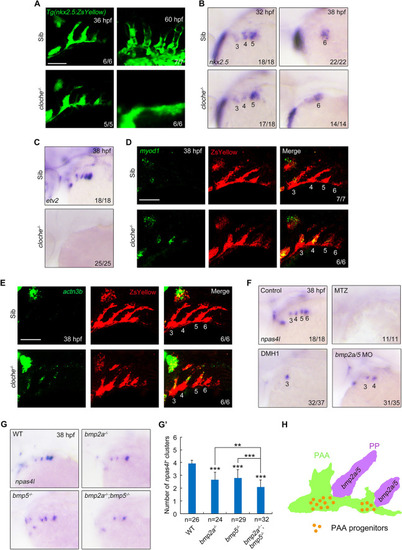
npas4l plays a pivotal role in the specification of PAA progenitors. (A) Live confocal images of npas4l−/− mutants and their wild-type and heterozygous siblings in Tg(nkx2.5:ZsYellow) background. Scale bar: 50 μm. The npas4l gene is also called cloche. (B,C) The expression patterns of nkx2.5 (B) and etv2 (C) were analyzed in npas4l−/− mutants and their siblings by in situ hybridization. (D,E) The expression of myod1 (D) and actn3b (E) in the pharynx were analyzed in npas4l−/− mutants and their siblings in Tg(nkx2.5:ZsYellow) background. The embryos were first subjected to fluorescent in situ hybridization with myod1 or actn3b probe, and then stained with anti-ZsYellow antibody. (F) Tg(nkx2.3:KalTA4-p2a-mCherry;UAS:NTR-mCherry) embryos were treated with 10 mM MTZ from bud stage and wild-type embryos were treated with 10 μM DMH1 from 24 hpf or injected with 2 ng bmp2a MO together with 4 ng bmp5 MO at the one-cell stage. The resulting embryos were harvested for in situ hybridization with npas4l probe at 38 hpf. (G,G′) Expression analysis of npas4l in bmp2a−/− or bmp5−/− single mutants and bmp2a−/−;bmp5−/− double mutant embryos (G). The average numbers of npas4l+ clusters were quantified from three independent experiments and the group values are expressed as mean±s.d. (G′). Student's t-test was used to determine the significance of differences between wild-type animals and indicated mutants, and one-way ANOVA test was performed to analyze the statistical differences between bmp2a−/−;bmp5−/− embryos and bmp2a−/− or bmp5−/− single mutants. **P<0.01, ***P<0.001. (H) Working model depicting that the specification of PAA progenitors from pharyngeal mesoderm is dependent of the activation of BMP signaling by bmp2a and bmp5 expressed in pouch endoderm.
|